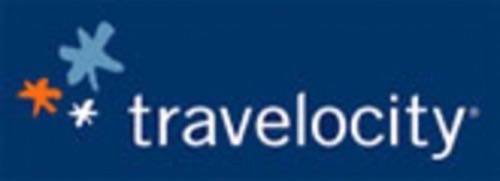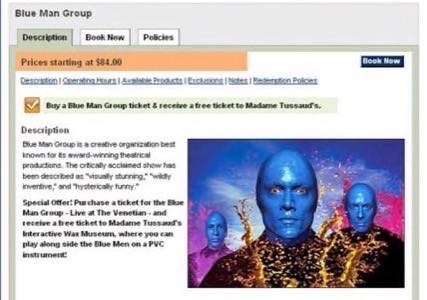We have already discussed Yahoo! Travel and TripAdvisor from a Web 3.0 perspective. Continuing our look at the online travel industry we will evaluate Travelocity next.

Travelocity, launched in 1996, is an online travel agency, and is owned by Sabre Holdings. According to Nielsen//NetRatings, Travelocity is ranked number two among the most-visited travel sites in the world with over 13 million visitors per month.
In general, most travel sites that have been around for a while offer a certain baseline set of functionality, that including Airline, Hotel, and Car Rental Bookings, as well as Vacation Packages, Cruises and Deals. I am looking at where these sites need to go in the Web 3.0 era.
Context
Context, so far, is limited to two rather broad areas: Business Travel and Pleasure Travel. In my opinion, this is hardly enough, since both Business Travel and Pleasure Travel come in many forms. Business Travel could be hyper luxury, i.e., a CEO traveling with his Board of Directors and the entire team staying at the Four Seasons, or it could be a sales rep of a startup going to a tradeshow, and staying in the cheapest motels possible.
Similarly, pleasure travel can also swing to both ends of the spectrum. The luxury traveler in search of the finest Aman resorts is a very different “context” than the student backpacker looking for Youth Hostels. I would like to see these Context nuances included as options in the navigation.
Travelocity, having been around for so long, has a vast amount of content and inventory. Without Contextual navigation, this repository of information is way too time-consuming and click-consuming to plod through.

Content
Travelocity is rich in content and covers information for over 700 airlines, more than 50,000 hotels and about 50 car rental companies across the world. The site offers over 6,500 vacation packages, tours and cruises and has travel content in 12 languages including English, French, and German.
The interesting differentiated aspects are what I will focus on. Travelocity is the only major travel site that allows users to book train tickets.
TravelocityÄôs Activities section is also nice. It allows you to book theatre and sports tickets, site seeing tours, etc. in more than 200 cities. It clearly stands out. I would, however, like Travelocity to include local festivals as well.
Going back to my earlier example of planning a trip in Andalucia (Southern Spain), let’s say I am looking to stay at small, romantic Bed & Breakfasts in various cities and small villages: Toledo, Granada, Cordoba, Seville, Arcos De La Frontera, etc. I want to know how the local festival dates line up with my travel dates, and how should I arrange my trip to work those in.
Also, local entertainment and local reviews are super important, and a mashup of information from the travel guides (Lonely Planet, Rough Guide, Guide du Routard), review sites (Yelp, Chowhound, CitySearch), would be very nice to access through Travelocity.
Further, I like to dance the Argentine Tango, and I would love to be able to know where to go dancing and when, in each city, from right within the Travelocity environment, without having to go scouting separately on the web.
None of this exists yet, but in this age of mashups, it ought to. The place-smart search technology exists, to tag local content in a way that sites can mash them up easily. Travelocity should investigate a small Canadian company called Cquay, to make this happen.
Community
Travelocity lacks good community features. The only community feature that deserves mention is hotel and tour review, but that is old functionality. They should take a lesson from TripAdvisor, whose Community features are simply fantastic. The site does allow photo sharing with collaboration via Snapfish, trying to emulate Yahoo’s integration of Flickr. Good idea. Not a great implementation, though.
Commerce
Travelocity earns commission on hotels and other services booked through its site, which is pretty much the standard revenue model in this business. The site, in collaboration with Hotlink, sells its “Gnome” range of merchandise, and does a much better job at it than TripAdvisor but still leaves a lot to be desired. A good innovation is the Travelocity Hotel Gift Card and the Travelocity Credit Cards. Travelocity Rewards MasterCard is a good co-branding strategy that the site is pursuing in collaboration with MasterCard.
Personalization
Travelocity’s personalization options allow users to view and save their trips, receive alerts about low airfares to favorite destinations by emails in collaboration with FareWatcher, receive change notifications, upload and share photos. Nothing great. Nothing earth shattering.
What would be earth shattering: integration with the frequent flyer programs of various airlines. The day Travelocity can automatically book a coach class ticket on British Airways, and then use my miles to upgrade it to business class, capture my meal preferences, and order special diets at the hotels I reserve through them, I would give them better points for Personalization.
Another area of Personalized service that I wish they would tackle, is taking care of all the little behind the scenes adjustments automatically if I need to change travel dates on a specific, complex itinerary. That would make me leap for joy, as this is one of the most painful things in life. I will write about a small startup that is attempting innovation in this area soon.

Vertical search
I found vertical searches in Travelocity to be more user-friendly than TripAdvisor. By and large, all the Airline, Hotel, Car Rental searches happen as one would imagine, but there is no imagination in any of this quite yet.
They should think of vertical search based on Context. In the Context of First Class Business Travel, the search interface should look very different, than how it looks in the context of budget backpacking vacations. The requisite amenities, the navigation and search options presented to the user, all need to be different.
Business Model
Travelocity makes most of its revenues on commissions. However, with an Alexa traffic rank of 604, according to comScore, Travelocity is one of the most effective advertising options for sponsored search advertisers, having a 6.5% click-through rate, compared to the 4 – 5 percent click-through rates achieved by Expedia or Orbitz. The advertising rates for Travelocity vary between $25 – $55 CPM. Travelocity earned revenues of $1.1 billion in 2006, an increase of 31% over 2005.
Conclusion
My final Web 3.0 Rating for Travelocity: Context: B+; Content: B+; Community: C; Commerce: A; Personalization: C; Vertical Search: C; Overall : B-










